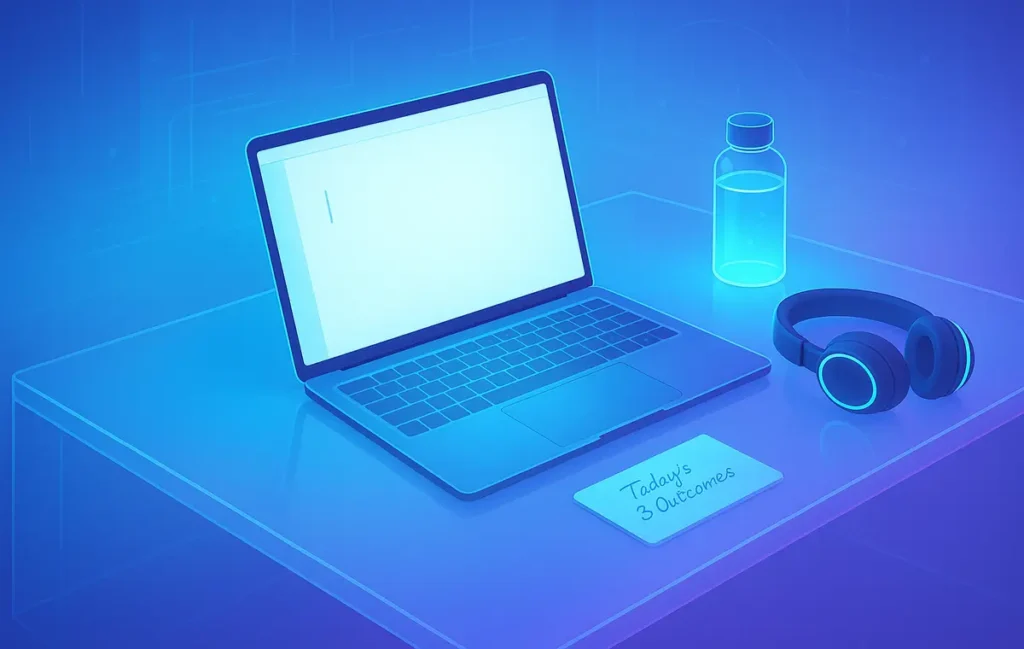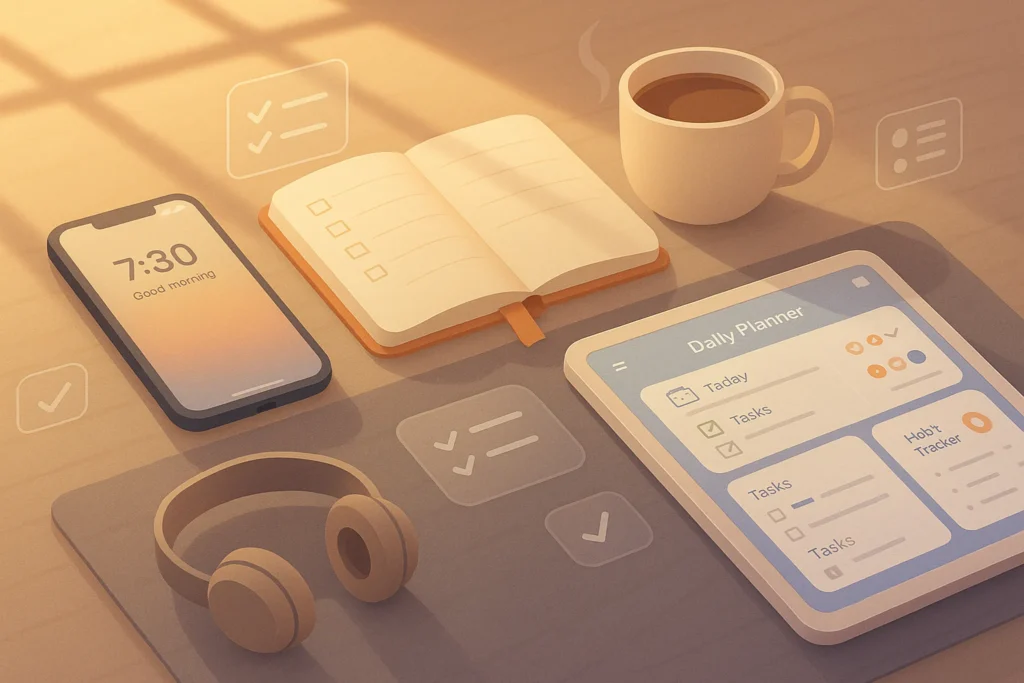🎯 Intro: Focus Is Your Competitive Edge—Treat It Like a Product
We’re living inside a casino for attention. Notifications blink like slot machines, feeds refresh endlessly, and work apps whisper “just a minute” that turns into a lost afternoon. Yet focus—sustained, high-quality attention—has become the scarcest resource in modern work. The difference between average and exceptional is increasingly not talent, but the ability to defend cognitive bandwidth long enough to ship meaningful work. The good news: concentration isn’t a fixed trait. It’s an environment you design, a routine you engineer, and a set of agreements you negotiate with your tools and your team.
In this NerdChips pillar, you’ll get a complete, pragmatic system: rituals that prime your brain, tech setups that actually reduce noise, block-scheduling that respects how attention recovers, and social/environmental tweaks that keep the whole machine running. If you want deeper context on the attention economy, bookmark Mastering Focus in the Age of Digital Distractions. If you’re building long, uninterrupted work arcs, pair this with Deep Work 101 and Time Blocking vs. Pomodoro. For the science-leaning readers, Top Productivity Hacks Backed by Science unpacks the research, and Digital Minimalism helps you declutter the tech that’s cluttering your mind.
💡 Nerd Tip: Don’t try to “be disciplined.” Engineer your environment so the easiest behavior is the right one.
🧠 Why Focus Is Harder Than Ever—and Why You Can Still Win
Focus didn’t get weaker; friction got lower. The cost of context switching plummeted to a swipe and a tap, but the cognitive cost remained. Most people underestimate how long it takes to return to baseline after even a brief interruption—often several minutes of degraded performance, multiplied across a day. Add always-on culture to that cocktail—Slack lights up on three devices, email pings across watch and phone, group chats never sleep—and you’re in a constant state of “partial attention,” where your brain is scanning for threats and novelty instead of diving into strategy, creativity, or deep technical work.
The other culprit is tool sprawl. Work lives in email, chat, docs, PM tools, and dashboards. Each system has its own notifications, badges, and “helpful” nudges. It’s death by a thousand toggles. The answer isn’t to reject tools; it’s to design a focus-first architecture: a default state where noise is quarantined and deep work can flourish. That means time-boxing high-value tasks, batching shallow work, and centralizing communications so signals don’t scatter across apps. It also means using the same levers the attention economy uses on you—triggers and rewards—but in your favor.
💡 Nerd Tip: A single message popping into view is not “just a second.” Treat every unscheduled interruption as a 10-minute tax—and optimize accordingly.
If you keep feeling like your attention is thinner than it used to be, it’s not a personal failing—it’s the system you’re working inside. We operate in an economy that monetizes micro-interruptions and low-friction novelty, which means the default state is “partially distracted.” For a deeper look at how notification design, feed loops, and tool sprawl fragment working memory—and what to do about it at the ecosystem level—see Mastering Focus in the Age of Digital Distractions. It unpacks the attention traps you can’t see during the day and gives you levers to reduce ambient noise before you even start your next deep block.
🧩 Pro Tips to Boost Focus (That You’ll Actually Use)
🔁 1) Rituals That Prime Your Brain (Make It Automatic)
Willpower is unreliable; rituals are automatic. Start by anchoring a pre-work sequence you repeat every time you begin a focus block. For example: water → two minutes of box breathing → put phone on a stand across the room → headphones on → one-page daily brief. The aim is to create sensory cues that tell your brain: “we’re entering deep work.” When your ritual is consistent, you need fewer mental arguments to begin; friction drops, and momentum increases.
Design your environment like a cockpit. One desk for deep work (no unrelated gear), one app for your task (full-screen, notifications off), and one list with the day’s three outcomes. If you must keep chat open, run it on a separate device with the window minimized and the badge hidden, or at least parked in a different virtual desktop. This reduces the micro-temptations that pull attention sideways.
A second anchor is time of day. Most people experience their clearest thinking within 2–4 hours of waking (after hydration and light movement). Guard that zone. Book meetings later, batch admin for the afternoon, and route creative or analytical tasks into your morning corridor. You’ll get more done with less effort because you’re surfing your biology instead of fighting it.
💡 Nerd Tip: Write a “start card” you can see at a glance: Today’s 3 Outcomes, First 10 minutes, Don’t do (apps/sites to avoid). Keep it on your desk like a checklist.
Rituals matter because they turn “start” from a debate into a reflex. When you run the same pre-work cues—water, breathing, headphones, one-page brief—your brain recognizes the pattern and slips into task-positive mode faster. If you want to formalize that routine into a repeatable practice with “entry” and “exit” protocols, borrow from the canon in Deep Work 101. It walks you through designing a personal deep-work template, choosing your trigger cues, and creating guardrails that survive messy days, not just perfect ones.
📱 2) Tech-Assisted Focus (Use Your Tools to Block Your Tools)
You don’t have to become a monk. You can make your devices collaborate. Focus apps like Freedom or Cold Turkey block distracting sites across devices on a schedule, which is better than ad-hoc willpower. For quick wins, set recurring sessions aligned to your work rhythms—say 9:00–11:30 and 14:00–16:30—so you’re never deciding in the moment whether to “just check” a feed.
Noise-cancelling headphones aren’t a luxury; they’re a “room you carry.” Pair them with a consistent audio context—brown noise, low-tempo instrumentals, or codec-safe “focus playlists.” The auditory routine becomes part of your entry ritual and muffles the unpredictable sounds that spike stress responses.
Streamline your tool stack. If you collaborate in multiple apps, route all urgent notifications through one channel. For example, everything mission-critical becomes a calendar alert or a single Slack channel with mentions; everything else is digest. Turn badges off almost everywhere. Use your OS to silence banners and dings while leaving calendar and calls from favorites alive. If you need social media for work, install an intent interstitial app like One Sec: it inserts a pause and asks what you’re about to do. That one-second wedge can save an hour.
💡 Nerd Tip: Move “fun apps” to the second screen on your phone and remove the dock. A tiny increase in friction yields disproportionate gains.
⏱️ 3) Scheduling Focus Blocks (Respect Attention’s Natural Rhythm)
The debate between Pomodoro and time blocking misses the point. The right cadence is the one that fits the task’s cognitive load and your ultradian cycles (roughly 90-minute attention waves). For deep work—coding, writing, design, research—plan 70–90 minutes on, then 15–20 minutes off. For shallow-but-necessary work—email, approvals, quick calls—batch into 30–45 minute containers once or twice daily.
Treat your calendar like a priority ledger, not a collage. Block your next day at the end of the current one, starting with one Hard Focus block in your strongest hours. Add Soft Focus for lighter thinking. Then add Admin and Meetings. If someone asks for your morning when it’s blocked, you already have an answer: “I’m heads-down then—how’s 2:30?” The block exists to be defended.
Guard your context as fiercely as your time. Group similar tasks: analysis with analysis, writing with writing. Context switches are silent killers; even two or three unnecessary pivots can erase an hour of quality output. Use separate browser profiles or desktops for different project contexts so tools and tabs match the cognitive mode you’re in.
💡 Nerd Tip: Name your blocks by outcome (“Ship page draft”) not activity (“Write”). Outcomes focus the mind; activities invite procrastination.
Cadence isn’t a religion; it’s a fit check between task complexity and your ultradian rhythms. Some people ship best in 90-minute arcs, others in tighter 45-on/10-off sprints when the work is detail-heavy. If you’re not sure which container matches your workload or energy curve, test both systems using the decision guide in Time Blocking vs. Pomodoro. You’ll get a simple framework to map cognitive load to block length, plus example schedules for writers, designers, analysts, and managers so you’re not reinventing the wheel.
🔕 4) Managing Notifications & Digital Clutter (Silence by Design)
Notification settings are your attention policy. If yours grew organically, they’re almost certainly wrong. Start from zero and re-add only what you miss. On iOS/Android, create Focus Modes: Work (only calendar + VIP calls), Writing (no calls, only time alerts), Personal (no work apps), Sleep (emergencies only). On macOS/Windows, make Do Not Disturb the default during work hours and whitelist calendar and conferencing. In Slack/Teams, set notification schedules and turn off channel banners; use mentions and keywords for true priorities.
Tame your digital surfaces. If your desktop is a landfill, your brain runs background processes to track it. Clear the deck, pin a single notes app, and keep only the day’s working files visible. Archive old chats, hide unused channels, and unsubscribe from newsletters you simply skim. If a message can wait, it should wait—route it to a daily or weekly digest.
Finally, design your phone’s home screen for calm. Page one: calendar, tasks, notes, camera, maps, and one “mindful” entertainment app (like a reading queue). No social, no news. Page two: everything else. It’s not puritanism; it’s user interface design for your mind.
💡 Nerd Tip: Delete every “red badge.” The color red hijacks threat detection. You’re not missing a fire—your app is manufacturing one.
Notification settings are your attention policy, and most people inherit them by accident. Start from zero, re-add only what you truly miss, and route everything else to digests. If your devices still feel loud after that pass, it’s a sign the problem isn’t settings—it’s surface area. Digital Minimalism gives you the step-by-step teardown: pruning apps, redesigning your phone’s home screen, separating “work” and “personal” profiles, and turning your OS Focus Modes into default, not exceptions. Calm isn’t a mood—it’s a configuration.
🧬 5) Biological Levers (Fuel the Brain That Does the Focusing)
No routine survives a body that’s depleted. Sleep, nutrition, hydration, light, and movement are the multipliers that make your focus system hum. Before chasing exotic nootropics, fix the fundamentals. Sleep: aim for a consistent window; even one late night can dent executive function the next day. Light: get outside within an hour of waking to anchor your circadian rhythm and improve alertness. Hydration: mild dehydration is enough to trigger fatigue and slow reaction time; keep water visible on your desk. Nutrition: avoid sugar spikes before deep work; pair carbohydrates with protein and fat to stabilize energy.
Movement is a cognitive switch. A 10-minute walk can reset attention after meetings. Light cardio before a deep session boosts blood flow and primes alertness. You don’t need to be an athlete; you need your biology to deliver steady energy. Use breaks to stand, stretch, breathe—not scroll.
If you’re experimenting with caffeine, set a cutoff and front-load your intake earlier. The goal isn’t max stimulation but a stable baseline. Gadget temptation is real, but a cheap timer and a full water bottle outperform most “focus toys” because they consistently change behavior.
💡 Nerd Tip: Try a 60-second “physiology reset”: inhale 4 seconds, hold 4, exhale 6, hold 2. Repeat 5 times. You’ll feel the system downshift.
Before you chase exotic “brain hacks,” the biggest gains come from boring-but-compounding fundamentals: consistent sleep windows, early daylight exposure, stable blood glucose, and short movement bursts before deep sessions. If you want evidence-graded tweaks with realistic effect sizes—what actually moves the needle versus what just sounds clever—bookmark Top Productivity Hacks Backed by Science. It translates research into practice, from how long a walk restores attention to how hydration affects error rates, so your focus setup has data behind it.
🧩 6) Social & Environmental Control (Make Focus a Team Sport)
You can’t be deeply focused inside an unspoken agreement to be instantly available. Change the agreements. Share office hours for quick questions and quiet hours for deep work. Encourage your team to put focus blocks on calendars so others can see and respect them. Create a shared language—“HARD FOCUS” = no pings; “SOFT FOCUS” = ping if urgent; “OPEN” = real-time OK.
Physical environment matters more than you think. Natural light, a clean desk, a comfortable chair, and a predictable temperature reduce micro-stress. If you’re in a noisy space, treat ANC + visuals as essential gear. At home, establish screen-free zones (bedroom, dinner table) so your brain has a place to land. A little ritual—closing the laptop and turning off the desk lamp—teaches your mind that work is over, which improves recovery and makes tomorrow’s focus easier.
Accountability also helps. A recurring check-in with a peer—15 minutes to declare goals and 15 to review—creates external pressure without micromanagement. In our experience with small teams, introducing shared quiet hours and accountability pairs increases weekly deep-work time by 20–30% within a month.
💡 Nerd Tip: Pin a one-line “availability contract” in your chat status: “Deep work 9–11:30 & 2–4:30. Mention me for urgent.” You’ve set expectations without drama.
⚡ Upgrade Your Focus Stack
Dial in your environment: Freedom/Cold Turkey for blocks, One Sec for intent, ANC headphones + a dedicated playlist. Build once—profit daily.
🎛️ The One-Page Focus Control Panel (Print-Ready)
Use this micro-checklist to start any deep session.
-
Environment: Desk cleared; one app full-screen; phone across room.
-
Ritual: Water → 2-minute breathing → headphones + playlist.
-
Outcomes: Write 3 results you’ll ship this block; open the doc/page now.
-
Boundaries: OS Focus Mode on; Slack/Teams to mentions only; email closed.
-
Timer: 70–90 minutes on; 15–20 minutes off.
-
Recovery: Quick walk or stretches; water refill; 60-second breathing.
Tape it to your monitor. When in doubt, run the panel.
🧯 Challenges & Fixes (Real-World Failure Modes)
“I fall into multitasking the minute I open the browser.”
Your browser is a carnival. Create a separate profile named FOCUS with zero extensions, no bookmarks bar, and a neutral start page. Open it only for deep work. Keep all “fun” tabs in a different profile. This hard split reduces impulse jumps.
“My team expects instant replies.”
Agree on escalation channels. For example: anything truly urgent = phone call or a dedicated “hotline” chat channel; everything else = async. Then stick to it. Over-responsiveness trains people to interrupt you. You can retrain them.
“I can’t stop thinking about other tasks.”
Your brain wants a holding area. Keep a scratchpad to the right of your main window. When a thought appears, dump it there and return to the task. At break time, triage the list into your task manager.
“Home is loud.”
If you can’t relocate, layer mitigations: ANC headphones + consistent white/brown noise + a visual barrier (a simple screen divider). Even partial shielding reduces cognitive overhead from unpredictable stimuli.
“Focus fades after lunch.”
Run an energy audit. Move heavy tasks earlier. Take a brisk 10-minute walk after eating. Try a 20-minute “non-sleep deep rest” audio. Shift admin to the afternoon. You’re not broken—your rhythms are.
💡 Nerd Tip: Your focus system is a product; iterate weekly. Keep a one-line log: “What broke my focus this week? What will I change?”
📬 Want More Smart Focus Systems?
Join the NerdChips newsletter for weekly playbooks on deep work, tool minimalism, and workflow design—built for founders, makers, and teams.
🔐 No noise. Just experiments that raise your output.
🧠 Nerd Verdict
Focus isn’t about heroics; it’s about architecture. When you align rituals, tools, schedules, biology, and team norms, attention becomes a renewable resource. The biggest shift is mindset: treat focus like a product you iterate. Run weekly experiments, measure what actually raises output, and codify the wins into your defaults. The organizations and creators that win the next decade won’t be the ones with the most apps; they’ll be the ones with the cleanest attention. That’s the NerdChips approach—minimal noise, maximal signal.
❓ FAQ: Nerds Ask, We Answer
💬 Would You Bite?
If you had to choose one upgrade to run today, would you commit to a 90-minute daily deep block or a two-hour digital detox each afternoon?
Tell us which—and why—and we’ll help you tune it. 👇
Crafted by NerdChips for creators and teams who want their best ideas to travel the world.



